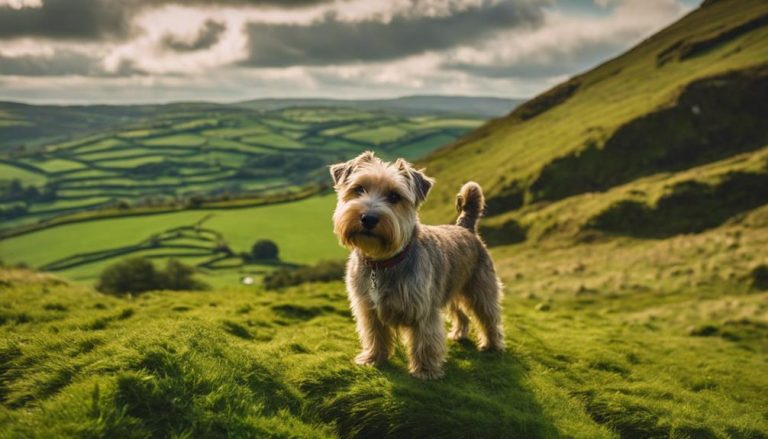Glen of Imaal Terrier Dog Breed: Irish Beauty
The Glen of Imaal Terrier hails from County Wicklow, Ireland, and is admired for its loyalty, affection, and toughness. This medium-sized dog breed was initially bred for hunting and farm duties, showcasing a hardy appearance with its notable bowed legs. These dogs are rare, meaning they need specific care and attention to thrive.
Their history is fascinating; they played vital roles during the Irish Rebellion and have become adept hunters and durable companions. Recognized by the Irish and American Kennel Clubs, there are now approximately 3100 of these dogs worldwide. To ensure they live happy, healthy lives, it’s essential to understand and meet their specific needs.
Taking care of a Glen of Imaal Terrier means acknowledging their rich heritage and adapting to their particular requirements. This helps maintain their health and honors their unique place in the dog world.
Key Takeaways
- Irish breed excels in hunting and adaptability.
- Rare, with global numbers of around 3100, it demands careful attention.
- Well-behaved when trained early; needs regular activity.
Quick Facts
Glen of Imaal Terriers are a medium-sized breed within the Terrier group known for their solid build. Males typically reach heights of 17-18 inches, while females stand slightly shorter at 16-17 inches. Their weight ranges from 35-45 pounds. These dogs have a strong and durable build that was initially bred for tasks like hunting and farm work. Their coarse and wiry coat protects them in harsh weather and rough environments. This coat comes in wheaten, blue, or brindle shades, adding to its visual appeal while serving a practical purpose.
These terriers were first bred in Ireland during the Elizabethan era by soldiers who wanted a dog that could work hard and move with agility. They mixed the local terriers with long-bodied hounds to get a breed known for its independence, loyalty, and affectionate demeanor. Glen of Imaal Terriers makes excellent companions and workers, living about 12 to 15 years. This longevity is a testament to their resilience and versatility, common traits in the Terrier group.
Overview
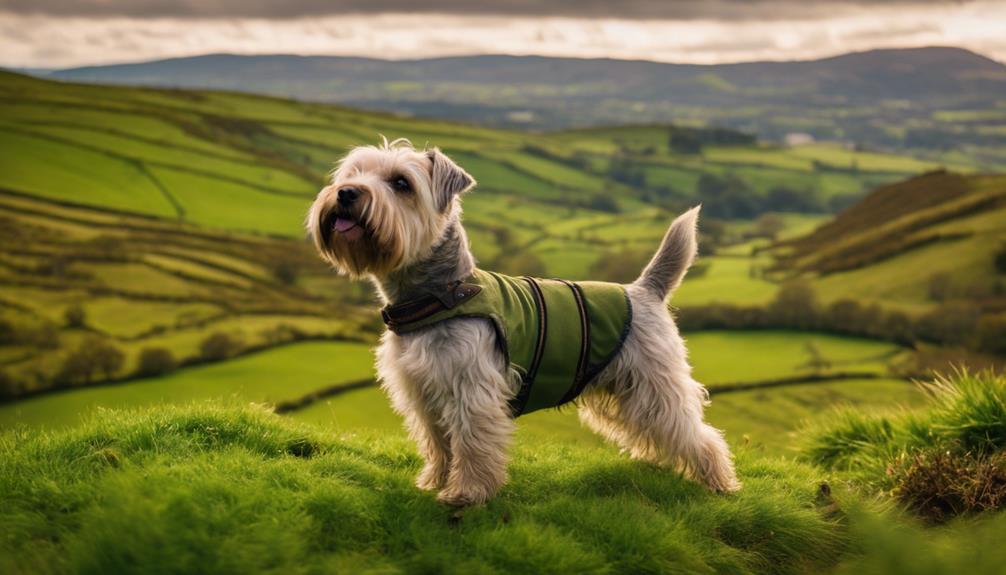
Building on the basics of Glen of Imaal Terriers, we dive deeper into what makes these dogs stand out in the Terrier Group. Known for their tough exterior, these terriers have a rich history of breeding in Ireland for specific tasks. Their main job was to hunt down foxes and badgers, which shows their strong work ethic and ability to handle rough terrains.
Glen of Imaal Terriers are easily recognized by their distinctive bowed front legs and strong back legs, making them excellent diggers and hunters. This breed is not just about muscle; they’re also known for being loyal, affectionate, and incredibly resilient companions.
Bringing a Glen of Imaal Terrier into your home means embracing a unique experience. Their rarity and the special attention they require make owning one rewarding. Their long history of careful breeding in Ireland has shaped them into esteemed members of the Terrier Group, beloved for their distinct qualities.
Irish Origin Insight
Located in the scenic County Wicklow of Ireland, the Glen of Imaal Terrier is a breed with deep roots in the area’s history and lifestyle. These dogs were first known for their hunting skills, especially with foxes and badgers. They played a vital role in homes as turnspit dogs, highlighting their adaptability and significance in rural settings.
The breed encountered a drastic decline, almost reaching extinction, until efforts in the early 20th century helped bring them back. Gaining official recognition from the Irish Kennel Club in 1934 was critical in preserving the breed. The American Kennel Club recognized it in 2004, boosting its international reputation. However, the global population of the Glen of Imaal Terrier is still tiny, with around 3100 dogs worldwide.
| Factor | Impact on Glen of Imaal Terrier |
|---|---|
| Irish Origin | Central to breed’s identity |
| Hunting and Utility | Influenced breed’s characteristics |
| Near Extinction | Sparked conservation efforts |
| Kennel Club Recognition | Guaranteed breed’s survival |
The Irish origins of the Glen of Imaal Terrier showcase the breed’s ability to survive, adapt, and remain beloved in the dog world.
Irish Rebellion Roots
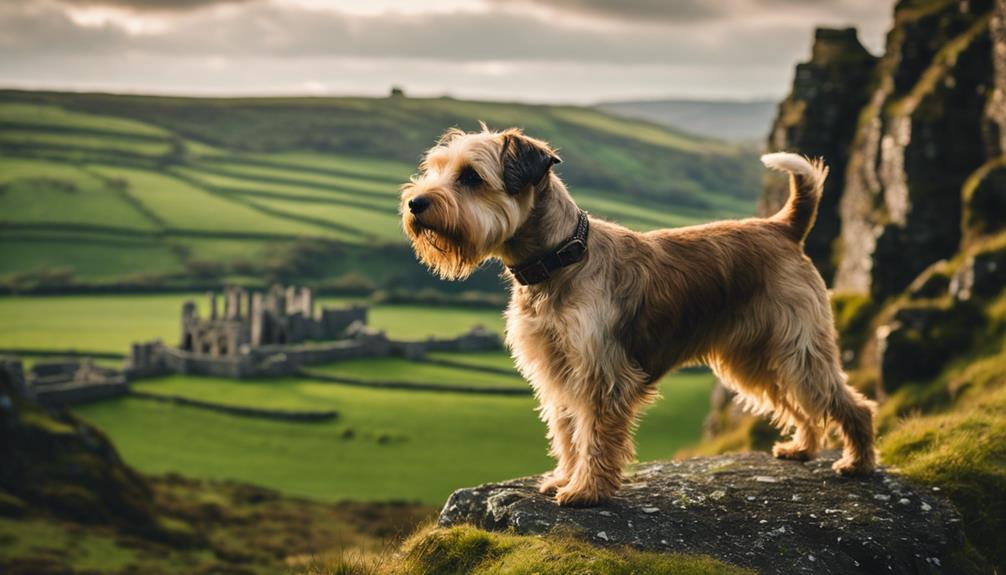
The Glen of Imaal Terrier is a breed with a rich history linked to Ireland’s tumultuous past, especially during the rebellions. This dog breed’s development was significantly shaped by the socio-political unrest of those times, turning it into a versatile and resilient animal. Its journey from a hunter and farm helper to taking part in local and national upheavals shows how it adapted to its environment’s changing needs and challenges. Today, it is a testament to adaptability and resilience, reflecting a deep connection to Irish history.
- Origin in Conflict: This breed emerged during Ireland’s socio-political upheavals.
- Historical Roles: It transitioned from a hunting and farm dog to serving in conflicts.
- Breed Evolution: Over time, it changed to suit its changing surroundings.
- Significance in Irish History: It symbolizes resilience and adaptability in the face of Ireland’s troubled past.
- Contemporary Relevance: It continues to carry its historical legacy while fitting into modern dog roles.
The Glen of Imaal Terrier’s history, from rising in conflict-stricken Ireland to its varied roles beyond just hunting rodents, highlights its ability to adjust and thrive. This breed’s story is about survival and thriving by adapting to new challenges, a quality that has cemented its place in Irish heritage and beyond.
Origin in Conflict
Born amid the Irish Rebellion, the Glen of Imaal Terrier was born out of a unique breeding strategy that brought together dogs from French and German soldiers. This breed hails from the rugged terrain of the Glen of Imaal in County Wicklow, Ireland. Its creation was a testament to the ingenuity and resilience displayed during challenging times. The breeders aimed to merge the superior qualities of long-bodied hounds and local terriers, leading to the birth of the Glen of Imaal Terrier. These dogs exhibit distinct traits that trace back to their unique origins.
Their story is deeply rooted in Ireland’s tumultuous history, highlighting the breed’s strong Irish heritage and the turbulent era it originated from. The Glen of Imaal Terrier symbolizes adaptability and strength, traits crucial for survival during the conflicts that marked its birth.
Historical Roles
The Glen of Imaal Terrier has a rich history dates back to the Irish Rebellion period. These dogs were bred during the time of Elizabeth I by soldiers who needed hardy dogs for the rough terrain. They mixed their long-bodied hounds with the local terriers to create an excellent breed for hunting and controlling the rat population on farms.
This breed, known for its strong work ethic, became vital to farm life. They were not just pets but workers who helped protect the food supply from vermin. The Glen of Imaal Terrier is one of Ireland’s four native terrier breeds, showcasing a deep connection to the country’s history. Despite their numbers dwindling and facing the threat of extinction, efforts in the early 20th century helped revive the breed.
Today, their role has expanded beyond just hunting and ratting. They are celebrated for their historical significance and their abilities as working dogs. Kennel clubs now recognize the Glen of Imaal Terrier’s contribution to Irish heritage and their enduring spirit as hunters.
Breed Evolution
Reflecting on their role in history, Glen of Imaal Terriers evolved significantly during the Irish Rebellion period, showing their adaptability and toughness.
These dogs came to be in Ireland under Elizabeth I, created from a mix of the long-bodied hounds brought by mercenaries from France and Germany and the local terriers. This mix aimed to develop a dog that excelled in hunting and labor, which were crucial skills during the unrest of the Irish Rebellion.
As one of Ireland’s four native Terrier breeds, Glen of Imaal Terriers stands out due to their distinct look and solid working instincts. Their development is closely linked with Irish history, marking them as a breed built for versatility and durability suited for the challenges of rural Ireland.
Medium Build
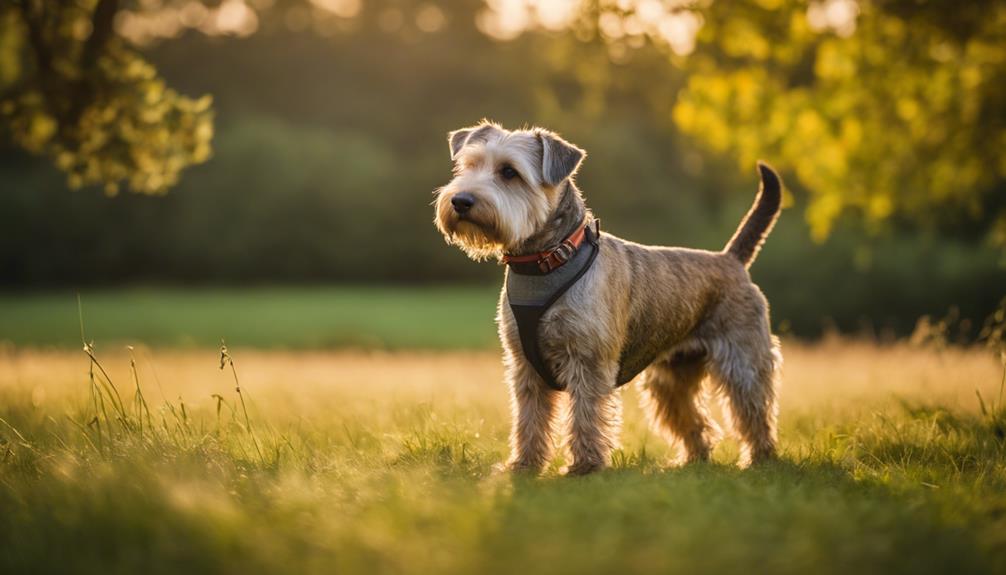
Caring for a Glen of Imaal Terrier with their medium size requires a detailed plan to ensure they stay healthy and lively. Knowing their ideal weight, how much exercise they need, what food is best for them, and health and grooming advice is critical. This ensures your terrier enjoys a whole, active life.
- Ideal Weight Range
- Exercise Needs
- Diet Recommendations
- Health Tips
- Grooming Advice
Ensuring your Glen of Imaal Terrier stays within the recommended weight range is vital for their overall health. This not only prevents obesity but also reduces the risk of related health issues. Regular exercise is also crucial. These terriers thrive on daily walks and playtime to keep fit and prevent boredom.
A balanced diet tailored to their needs supports their energy levels and health. High-quality dog food matches their age, size, and activity level. Paying attention to their health is equally important. Regular vet check-ups can catch any issues early and keep your terrier in shape.
Lastly, grooming is more than just keeping them looking good. It’s about maintaining their skin and coat health, checking for any signs of issues, and bonding with your pet. A routine that includes brushing, nail trimming, and ear cleaning will keep your Glen of Imaal looking and feeling great.
Ideal Weight Range
Keeping a Glen of Imaal Terrier of medium build at a healthy weight is crucial. They should weigh between 35-45 pounds to stay healthy and agile. This weight range is carefully chosen to match their size and build, helping them live a balanced and healthy life. Staying within this weight bracket is vital because being under or over it can lead to health problems and reduce their quality of life.
Regular check-ups with a vet are recommended to keep a Glen of Imaal Terrier’s weight on track. This helps them stay in the ideal weight range, supporting their wellbeing, mobility, and happiness.
Exercise Requirements
Glen of Imaal Terriers are medium-sized dogs that need a lot of exercise to stay healthy and happy. Taking them for daily walks and having play sessions are vital to keeping them in top shape. These activities help keep their minds sharp and their bodies strong. Playing fetch or going through agility courses are great ways to ensure they get enough physical activity. These kinds of exercises are not just fun for them; they also help improve their agility and strength, which is essential for their size.
Regular physical activity helps prevent them from getting bored and developing behavior problems. It’s important to mix up their activities to keep them challenged. This ensures they have a comprehensive exercise routine that supports their overall wellbeing.
Nutrition Guidelines
A balanced diet is crucial for the health and energy of a medium-built Glen of Imaal Terrier. Their meals should mainly consist of high-quality dry kibble, which can be mixed with some wet food now and then to meet their nutritional needs. Watching their calorie consumption is critical to avoiding overweight issues and keeping them healthy. This means being consistent with their meal times and how much they eat.
Having fresh water available at all times is vital for their health. If you’re unsure about the best diet for your Glen of Imaal Terrier, talking to a vet or a dog nutrition expert can help tailor a diet plan that fits their needs, ensuring they stay healthy and happy for years.
Health Considerations
Keeping Glen of Imaal Terriers in top health requires attention to specific health issues they might face. These dogs are generally healthy but can have particular problems.
For example, allergies can make them scratch, especially around their paws. Hip dysplasia is another concern, though it’s usually not severe in this breed. Breeders must check their dogs’ hips through OFA or PennHIP to ensure they’re suitable for breeding.
A genetic test for progressive retinal atrophy (type crd3) also highlights the need for early health checks to catch any inheritable conditions.
Understanding these health challenges is critical. Early screening can help manage or prevent these issues, ensuring a healthier life for these terriers.
Grooming Tips
Caring for Glenn of Imaal Terriers involves more than just health checks; their unique wiry coat also needs regular attention to stay in top shape. Brushing or combing their coats every one to two weeks is crucial for keeping them looking their best. This keeps their coat healthy and ensures they maintain their distinctive appearance.
Stripping their coat two to four times a year is another critical aspect of their grooming. This process helps maintain the coat’s natural texture and removes any dead hair. Unlike many dog breeds, preparing Glens for dog shows is relatively straightforward. Their grooming emphasizes their natural and rugged look, a plus for many owners.
It’s worth mentioning that tail docking, once typical for practical purposes, is now banned in several countries. This change highlights a move towards more animal-friendly grooming practices. In dog competitions, it’s essential for Glens to look neat but still retain their natural, unmanicured appearance. This approach to grooming respects the breed’s history and aligns with contemporary standards of animal care.
Bold Spirit
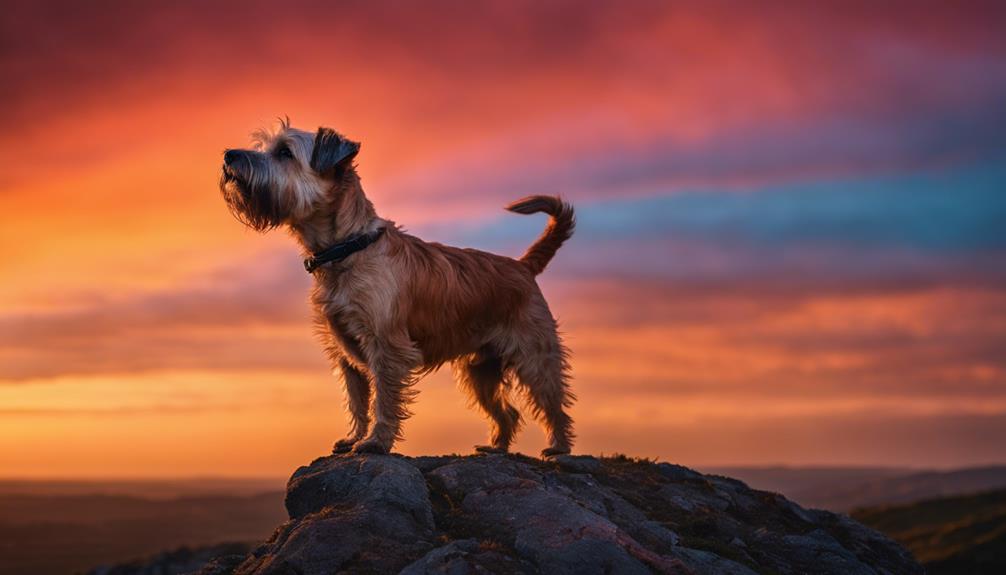
The Glen of Imaal Terrier is known for its bold spirit, which shines through in its confident way of engaging with the world around it. This characteristic is central to the breed, affecting how they should be cared for and trained. Understanding this trait is crucial to ensure a happy and well-adjusted dog.
Understanding Bold Spirit: A closer look at what makes the Glen of Imaal Terrier’s spirit so vibrant and bold.
Behavior Traits: An exploration into the behaviors that demonstrate their fearless nature.
Acts of Bravery: Examples of how their courage comes into play in various situations.
Training Challenges: Discuss the hurdles their boldness creates during training and how to overcome them.
The Role of Socialization: Highlighting why early and consistent socialization is critical in shaping their bold personality positively.
The Glen of Imaal Terrier approaches life with admirable confidence and a point to consider when training. Knowing this trait’s intricacies helps raise a joyful and balanced terrier.
A detailed look into their bold and spirited nature reveals much about the Glen of Imaal Terrier.
Their behavior showcases a fearless approach to life, something that’s both a strength and a challenge.
They do not shy away from challenges, often displaying remarkable bravery. However, this trait can make training tricky, demanding patience and understanding.
Early and continuous socialization is vital in managing their spirited behavior, ensuring they grow into well-mannered adults. Understanding and nurturing their bold spirit is essential for a fulfilling relationship with this unique breed.
Defining Bold Spirit
The Glen of Imaal Terrier stands out for its resilience and energy, making it a prime example of what people love about terrier breeds. Unlike other terriers, it has a calmer and more composed nature but keeps that determined and lively essence. This breed started as a hunter, showing off its bold spirit in its work. It’s energetic but also known for being relaxed and easygoing, offering a well-rounded character.
With its thick coat and sturdy build, the Glen of Imaal Terrier is always ready for action, embodying the true spirit of a hardworking terrier. This breed’s origin as a vermin hunter has equipped it with a strong determination, which is evident in its behavior. Despite its lively nature, it maintains a calmness and laid-back approach, striking a perfect balance in temperament.
Temperament Traits
Glen of Imaal Terriers are known for their dynamic temperament, combining a solid working instinct with a calm nature. This mix makes them both spirited and playful. Despite looking tough, they are very laid-back dogs, agile yet easygoing. Their history in demanding work environments contributes to their robustness.
Glen of Imaal Terriers are fast, agile, and love to play, making them perfect for those looking for an adaptable and energetic companion. However, they need early socialization and firm guidance from their owners to ensure their energy is directed positively. This helps build a strong bond between the dog and its owner.
Courageous Acts
Glen of Imaal Terriers are known for their bravery, especially in hunting. They have a bold approach to tracking down foxes, badgers, and other small games. This bravery is not just about being fearless; it’s deeply rooted in their terrier heritage. These dogs are determined and show a solid commitment to the tasks, making them excellent hunters.
Their history as hunting dogs is filled with tales of courage and persistence, especially notable when they pursue prey underground. Glen of Imaal Terriers don’t back down from challenges, which has earned them much admiration. Their willingness to tackle complex tasks head-on is a testament to their strong work ethic and dedication to their hunting duties.
Training Challenges
Training a Glen of Imaal Terrier involves understanding their bold character and independence, making them somewhat challenging. Their strong-willed nature and high prey drive can distract them during training, requiring a more thoughtful approach. To address this, using positive reinforcement like treats and praise works well in keeping them engaged.
Early socialization and showing consistent leadership are crucial. These steps help manage stubbornness and ensure growth into well-behaved pets. It is vital to avoid traditional training methods and focus on what works specifically for them. This means being patient and adapting your strategies to suit their unique personality.
Socialization Importance
Socializing Glen of Imaal Terriers is crucial for their growth, helping them become well-behaved and friendly pets. These dogs must interact with various people, animals, and situations from a young age. This exposure helps them become confident and adaptable, preventing aggression and fear.
Early socialization helps these terriers feel comfortable in different settings. They learn to interact positively with new people, children, and other animals. This process prevents behavioral problems and ensures they become friendly and pleasant companions.
Ensuring Glen of Imaal Terriers meets many people and experiences various environments is vital. It teaches them how to handle new experiences with ease. As a result, they’re more likely to be friendly and calm around strangers and other pets, showcasing the importance of socialization in their overall development.
Genetic Conditions Monitoring
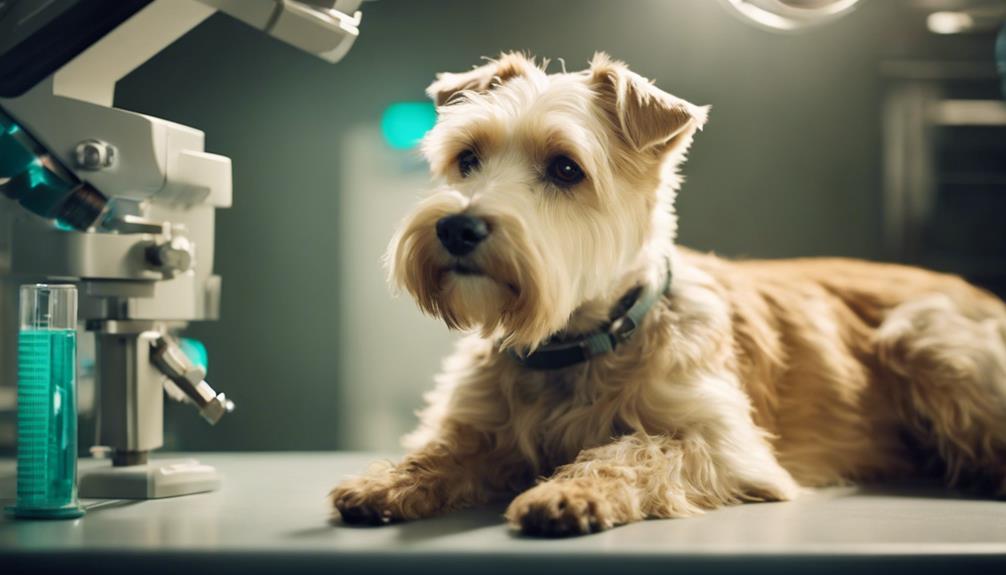
In Glen of Imaal Terrier care, paying attention to genetic conditions is crucial for the breed’s health and future. It’s essential to be aware of common genetic issues, the benefits of health screenings, and how to manage inherited conditions effectively. This approach helps breeders and owners reduce health risks and ensure the dogs live long healthy lives.
Progressive retinal atrophy (type crd3) genetic testing is a must for this breed. Although heart issues are rare, it’s good to keep an eye out for them. Allergies and skin irritation, particularly on the paws, are also common concerns. Some Glen of Imaal Terriers might develop mild hip dysplasia, so using OFA or PennHIP evaluations for breeding stock is wise to check hip health.
Understanding these conditions and taking preventive measures can make a big difference in the wellbeing of Glen of Imaal Terriers. It’s all about ensuring these dogs have the best chance at a healthy life.
Common Genetic Issues
For those who have Glen of Imaal Terriers, it’s essential to know about specific health issues that can affect them. These include progressive retinal atrophy, especially type crd3, as well as heart conditions, allergies, and hip dysplasia. Thankfully, there’s a genetic test for progressive retinal atrophy, which helps catch it early and manage the condition effectively.
Heart issues are rare in this breed, which is good news for their owners. However, allergies can be a problem, often showing up as itchy skin, especially around their paws. Hip dysplasia, on the other hand, tends to be mild but is still something to watch out for. Responsible breeders use evaluations from OFA or PennHIP to check the health of their dogs’ hips. This helps ensure the puppies they raise are healthy and have a good quality of life.
Health Screening Importance
Regular health screenings are essential for Glen of Imaal Terriers to catch and manage genetic conditions early on. Testing for progressive retinal atrophy (type crd3) is critical for spotting vision problems before they worsen.
Although heart issues are rare in this breed, their infrequency makes it even more vital to conduct thorough screenings to detect any unusual signs early. Breeders usually use OFA or PennHIP tests to check the hips for dysplasia and reduce its occurrence.
Keeping an eye out for allergies and skin conditions is also essential, as they can significantly affect a dog’s comfort and happiness. By focusing on comprehensive health screenings, breeders and owners can help ensure the health and longevity of Glen of Imaal Terriers.
Managing Hereditary Conditions
A focused plan is essential to keep Glen of Imaal Terriers healthy, especially for conditions like progressive retinal atrophy, hip dysplasia, and heart issues, even though they’re unfamiliar. A genetic test is available for progressive retinal atrophy. This test helps pinpoint carriers and affected dogs early on. Knowing this information allows breeders to make more intelligent choices and monitor puppies’ health.
Heart issues are rare in this breed, but watching for any signs of heart trouble is crucial. Hip dysplasia is usually mild in Glen of Imaal Terriers, but it’s still important to check. Breeders use OFA or PennHIP tests to check the hips of their dogs. This helps reduce the chances of hip dysplasia being passed down. Keeping an eye on allergies and skin conditions, like paw itching, is also critical to a dog’s health.
This approach ensures that Glen of Imaal Terriers live long, healthy lives. It’s all about being proactive and staying informed.
Grooming Essentials
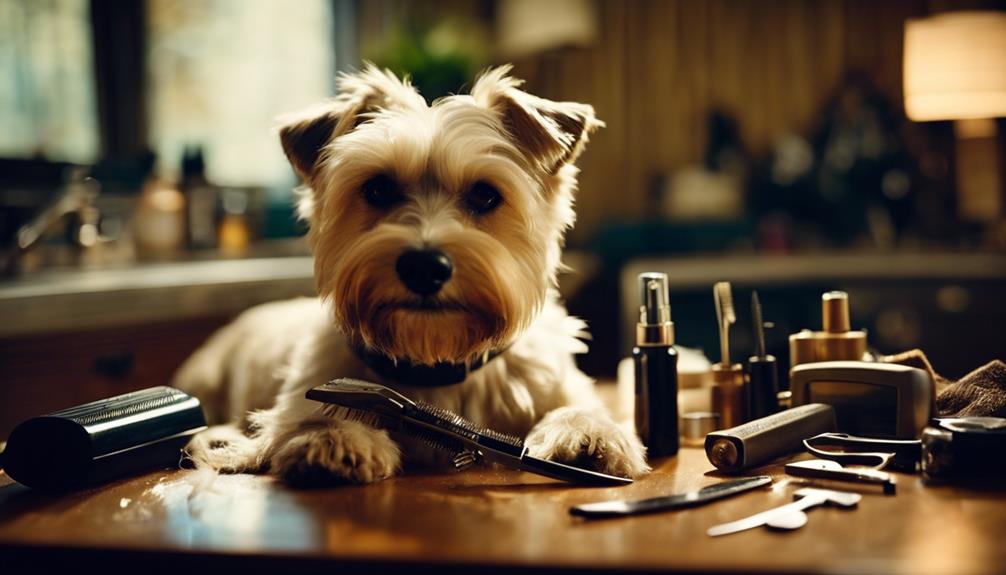
In our journey through the Glen of Imaal Terrier world, paying attention to grooming is crucial—their distinct double coat and overall cleanliness demand a reliable and orderly routine. Good grooming practices make them look better and are vital to their health and happiness.
- Coat Care Know-how: Knowing how the Glen of Imaal Terrier’s coat grows and changes is essential.
- Brushing Routine: Keeping up with regular brushing helps avoid tangles and keeps the coat in good condition.
- Bathing Methods: Using the proper techniques ensures that their skin and coats are cleaned well without causing any harm.
- Nail Care: Keeping their nails trimmed is necessary to prevent discomfort and keep them walking quickly.
- Ear Cleaning: Carefully cleaning their ears is necessary to prevent infections and keep their hearing sharp.
Understanding the growth cycle of the Glen of Imaal Terrier’s coat is step one in their care. Knowing this helps you tackle their grooming with confidence. Regular brushing sessions are a must to keep their coat free from mats and maintain its health. When bathing, choosing the proper methods is crucial to avoid drying out their skin or causing irritation. Trimming their nails frequently is essential for their comfort and to avoid problems with walking. Lastly, keeping their ears clean is crucial in preventing infections and ensuring they can hear well.
Using the correct products and tools can make a big difference in grooming. For example, investing in high-quality brush and nail clippers can simplify these tasks. Moreover, choosing a shampoo designed for dogs with sensitive skin can help maintain their coat’s health without irritation. These small steps contribute significantly to the overall wellbeing of your Glen of Imaal Terrier, ensuring they stay happy, healthy, and looking their best.
Coat Care Basics
To keep a Glen of Imaal Terrier’s distinctive double coat, which combines a wiry top with a soft undercoat, in top shape, owners must brush or comb through it every couple of weeks. This routine grooming does more than keep them looking good – it’s crucial for their health, too, helping to prevent painful mats and tangles.
Stripping the coat of dead hair a few times a year is also necessary. This process involves thinning out the dead hair, which is critical for stimulating new growth and keeping the coat’s texture right.
Unlike many breeds, grooming for show involves keeping things simple and natural, focusing on a neat look that sticks to the breed standards without excessive trimming or styling.
Brushing Frequency
When caring for a Glen of Imaal Terrier, keeping up with their coat maintenance is critical. Brushing or combing their coat every one to two weeks is essential. This practice helps maintain their coat’s health, reduces shedding by removing dead fur, and spreads their skin’s natural oils evenly.
Regular grooming also involves removing extra hair from their wiry coat two to four times a year. This step is vital to preserve the breed’s distinct look. Unlike many breeds, Glen of Imaal Terriers doesn’t need extensive grooming for shows. They look their best with a simple, natural style that doesn’t involve intricate clipping or styling.
Bathing Techniques
To keep a Glen of Imaal Terrier‘s coat in top condition, it’s recommended to bathe them every two to three months. Use a gentle dog shampoo designed for terriers to avoid irritating their skin. Their coat and skin are unique, so choosing the right shampoo matters. It should cater to their specific needs and not strip their skin of moisture or cause any irritation.
During the bath, make sure to rinse the coat thoroughly. Leaving shampoo residue behind can irritate the skin and lead to dryness. After the bath, using a towel to dry off the excess water will make drying quicker. A brushing session after drying helps to untangle the coat and prevent mats, keeping your Glen of Imaal Terrier looking and feeling great.
Nail Trimming Tips
Regular nail trimming is crucial for keeping a Glen of Imaal Terrier healthy and comfortable. You’ll need specific dog nail trimming tools to ensure you don’t hurt your pet. Cutting the nails at the right length is critical to avoid bleeding and pain. Cutting them too short can harm the sensitive part of the nail, known as the quick.
If you’re unsure how to trim nails correctly, it’s wise to ask for help from a professional groomer or veterinarian. They can show you the right way to do it. Keeping your dog’s nails trimmed is a big part of caring for their paws and helping them move around quickly.
Ear Cleaning Guide
Maintaining the ear health of a Glen of Imaal Terrier is as crucial as taking care of their nails. Cleaning their ears properly is critical to avoiding infections and ensuring they stay healthy. It would be best to use a vet-recommended ear cleaner, applying it gently with cotton balls around the outer part of the ear canal. It’s essential not to use cotton swabs or to put anything directly into the ear canal to prevent injuries.
Regular ear cleaning is not just about keeping the ears clean; it also helps spot any ear issues early on. Always check with your vet on how often you should clean your Glen of Imaal Terrier’s ears to keep them free from infections and healthy.
Dietary Needs Overview
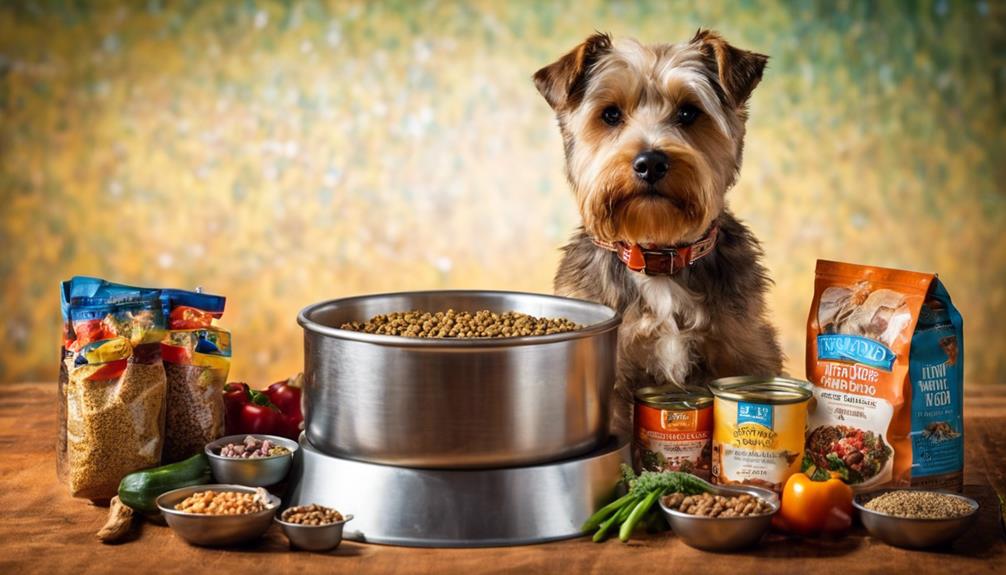
The dietary needs of the Glen of Imaal Terrier are complex, requiring a thoughtful mix of nutrients for optimal health and energy. Owners must grasp their specific nutrition needs, pinpoint potential food sensitivities, and follow a regular feeding routine. This guide aims to arm you with the knowledge to satisfy the dietary requirements of your Glen of Imaal Terrier.
Nutritional Needs are vital, as these terriers thrive on a balanced diet that supports their energetic lifestyle. High-quality proteins are essential for muscle maintenance, while fruits and vegetables provide necessary vitamins and minerals. Including these in your dog’s diet supports their overall wellbeing.
Food Allergies can be an issue. Common triggers include beef, dairy, and wheat. Paying close attention to your dog’s reaction to different foods is crucial in identifying and avoiding allergens.
Feeding Schedule Advice: Consistency is king. Establishing and adhering to a regular feeding schedule helps regulate your dog’s digestion and energy levels.
Quality Proteins play a pivotal role in your dog’s diet. They’re essential for building and repairing tissues. Opt for high-quality sources like chicken, fish, or lamb to keep your terrier in shape.
Incorporating Fruits and Vegetables is also beneficial. They’re not just fillers; they provide essential nutrients and fiber. Carrots, apples, and leafy greens can be great additions to your Glen of Imaal Terrier’s meals.
Understanding and meeting your Glen of Imaal Terrier’s dietary needs is crucial for their health and happiness. With the right balance of nutrients, attention to potential food allergies, and a consistent feeding schedule, your terrier will have everything they need to thrive.
Nutritional Requirements
A balanced diet with premium proteins like meat, fish, and poultry is vital for the muscle growth and overall health of Glen of Imaal Terriers. These nutrients support their energetic lifestyle and keep them in top shape.
It’s important not to give them leftovers or human food, as this can lead to weight gain and unbalanced nutrition, which might harm their health. Talking to a vet about the right food amounts and when to feed them is a good idea based on their specific needs.
Always ensure they have access to fresh water to stay hydrated and healthy.
Common Food Allergies
Glen of Imaal Terriers, like other dog breeds, may have food sensitivities that impact their health. They often react poorly to certain ingredients such as beef, chicken, dairy, and grains. These reactions can cause itching, skin issues, stomach problems, and ear infections.
To help these dogs, owners might switch to a diet with fewer ingredients or hypoallergenic. It’s critical to work with a vet to pinpoint the exact cause of the allergy and develop a diet that avoids these triggers.
Providing a high-quality and well-balanced diet is critical to managing Glen of Imaal Terriers food allergies.
Feeding Schedule Tips
In addressing food allergies specific to Glen of Imaal Terriers, it’s crucial to tailor their feeding schedules to meet their dietary needs. Choosing high-quality, age-appropriate dog food is the key, with adult Glens thriving on two meals daily to keep their energy consistent. Puppies might need their food divided into 3-4 portions daily to support their rapid growth and development properly.
Keeping an eye on your Glen’s weight and activity level helps adjust meal sizes to keep them in top shape. This approach benefits their overall health and aids in training by ensuring they’re always ready to learn and perform. If you’re looking to create a diet that’s just right for your Glen, getting advice from a vet is a smart move to ensure their nutritional needs are fully met.
Frequently Asked Questions
Are Glen of Imaal Terriers Good Pets?
- Glen of Imaal Terriers are loyal and spirited.
- They have a moderate temperament, ideal for families.
- Known for their gentle nature, they make great companions.
How Rare Is a Glen of Imaal Terrier?
- Glen of Imaal Terriers are pretty uncommon, with few registered.
- They stand as a notable Irish terrier breed, highlighting their uniqueness.
- Their recognition by major kennel clubs marks their rarity.
Can Glen of Imaal Terriers Be Left Alone?
- Glen of Imaal Terriers handles brief alone times well.
- Avoid leaving them solo for over 4-6 hours to prevent stress.
- Separation anxiety might lead to unwanted chewing or barking.
How Many Glen of Imaal Terriers Are There in the US?
- Around 600-700 Glen of Imaal Terriers exist in the US.
- Their scarcity highlights dedicated breed enthusiasts’ work.
- This breed remains a rare presence in America.

